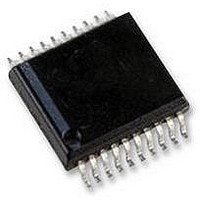AS5134-ASSU austriamicrosystems, AS5134-ASSU Datasheet - Page 22

AS5134-ASSU
Manufacturer Part Number
AS5134-ASSU
Description
ENCODER, MAGNETIC, ROTARY, 8BIT, 20SSOP
Manufacturer
austriamicrosystems
Datasheet
1.AS5134-ASSU.pdf
(39 pages)
Specifications of AS5134-ASSU
Brief Features
9-Bit Multiturn Counter, User Programmable Zero Position And Sensitivity
Supply Voltage Range
4.5V To 5.5V
Operating Temperature Range
-40°C To +140°C
Digital Ic Case
RoHS Compliant
Ic Function
Programmable High Speed Magnetic Rotary Encoder
Rohs Compliant
Yes
AS5134
Data Sheet - D e t a i l e d D e s c r i p t i o n
Figure 16. Extended Operation Mode (for OTP access only)
AS5134 Status Indicators
Lock Status Bit
The Lock signal indicates, whether the angle information is valid (ADC locked, Lock = high) or invalid (ADC unlocked,
Lock = low). To determine a valid angular signal at best performance, the following indicators should be set:
Lock = 1
AGC = >00H and < 2FH
Note: The angle signal may also be valid (Lock = 1), when the AGC is out of range (00H or 2FH), but the accuracy of
Magnetic Field Strength Indicators
The AS5134 is not only able to sense the angle of a rotating magnet, it can also measure the magnetic field strength
(and hence the vertical distance) of the magnet. This additional feature can be used for several purposes:
The magnetic field strength information is available in two forms:
Magnetic Field Strength Software Indicator
The serial data that is obtained by command READ ANGLE contains the 6-bit AGC information. The AGC is an
automatic gain control that adjusts the internal signal amplitude obtained from the Hall elements to a constant level. If
the magnetic field is weak, e.g. with a large vertical gap between magnet and IC, with a weak magnet or at elevated
temperatures of the magnet, the AGC value will be high. Likewise, the AGC value will be lower when the magnet is
closer to the IC, when strong magnets are used and at low temperatures.
The best performance of the AS5134 will be achieved when operating within the AGC range. It will still be operational
outside the AGC range, but with reduced performance especially with a weak magnetic field due to increased noise.
Factors Influencing the AGC Value
In practical use, the AGC value will depend on several factors:
www.austriamicrosystems.com
DCLK
- as a safety feature by constantly monitoring the presence and proper vertical distance of the magnet
- as a state-of-health indicator, e.g. for a power-up self test
- as a pushbutton feature for rotate-and-push types of manual input devices
The initial strength of the magnet. Aging magnets may show a reducing magnetic field over time which results in
an increase of the AGC value. The effect of this phenomenon is relatively small and can easily be compensated by
the AGC.
The vertical distance of the magnet. Depending on the mechanical setup and assembly tolerances, there will
always be some variation of the vertical distance between magnet and IC over the lifetime of the application using
the AS5134. Again, vertical distance variations can be compensated by the AGC.
The temperature and material of the magnet. The recommended magnet for the AS5134 is a diametrically mag-
netized, 5-6mm diameter NdFeB (Neodymium-Iron-Boron) magnet. Other magnets may also be used as long as
DIO
DIO
DIO
CS
the AS5134 may be reduced due to the out of range condition of the magnetic field strength.
t0
t1
CMD4
t3
t4
CMD_PHASE
HI
CMD2
CMD0
t5
t6
Revision 1.8
D61
D61
DATA_PHASE_EXTENDED
t8
t12
t7
D60
t11
D60
D0
D0
t10
t10
t9
CMD
READ
WRITE
22 - 39













